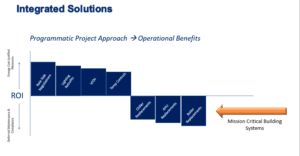Tim Geiger is the President of Stark Tech Group. The Stark Tech Group is a Master-level BMS EcoXpert™.
As building owners and managers work through their annual budgeting cycles, building upgrades and maintenance decisions are made based on both return on investment (ROI) and on business risk avoidance. According to the Building Owners and Managers Association (BOMA), repair and maintenance account for roughly 12 percent of total expenses. However, in many cases, management falls into a pattern where needed building maintenance is underfunded. Over time, this deferred building maintenance approach (“the we’ll take care of it next year approach”) begins to pose serious risks. The cost of the eventual fixes continues to climb each year and the prospect of a catastrophic failure (like loss of the main boiler or chiller plant) becomes very real. When such an event occurs, the loss of the business can soon follow.
Why would organizations put themselves into such a precarious position? Many times, it comes down to human nature and the need to follow the path of least resistance. To a CFO, the maintenance-related budgetary requests coming in from building facilities staff can often be difficult to visualize. Physical infrastructure systems (power, cooling, heating) operate behind the scenes and seem to silently perform their jobs year after year. The thinking can be “it has worked for 25 years now, certainly it can still work for 26.” In addition, the cost of fixing these systems is often high and always appears as an unexpected, unwanted budgetary item. Yet, over time a costly critical systems failure will result if no action is taken.
Pragmatic approaches for sensible funding of infrastructure maintenance
As an experienced building automation systems integrator and Schneider Electric master-level EcoXpert, our company, Stark Tech Group, works with building owners to avoid such a dilemma. We recommend a more programmatic approach to both planning and funding for building infrastructure maintenance.
Here’s what we recommend:
- Formalize the plan – When assembling an overall facility master plan, organize budgetary line items into categories represented by blocks (see Figure 1 below). These blocks are organized according to both ROI and business criticality. Those blocks above the center line can use utility negotiations to secure better rates and use savings to retrofit lighting systems, variable frequency drives and more. Temperature controls are an easy solution to boost energy efficiency but represent budgetary items with shorter return on investment (ROI). Those blocks below the center line— replacement of chillers and air handling units, replacement of boilers—are more critical but represent longer ROI.

- Make “blended” decisions – Once the key line items have been properly categorized, embrace a more blended programmatic approach which avoids addressing issues one at a time, and instead uses savings from multiple actions that reduce costs to pay for larger capital investments. The natural tendency for most organizations is to ONLY focus on those items listed above the line, ignoring the mission-critical work that needs to be done to address the systems below the line. Time is spent working with numerous vendors who singularly try to convince the enterprise to address one box at a time. Under such a scenario, the focus is on the financial enhancement of the facility today, rather than addressing mission-critical items below the line that have long-term impacts on the efficiency of the building.
- Alter the funding method – For long-term success and operational stability, use the gains accrued from those blocks above the center line (high ROI) to fund the maintenance and / or replacement of the items that are below the line (high criticality). In this way, deferred maintenance costs are kept to a minimum and the risk of catastrophic failure remains low.
Access resources on building maintenance approaches
To learn more about how Schneider Electric, working with EcoXperts, can help building owners operate and holistically maintain more reliable and sustainable buildings, visit the EcoStruxure™ Building web site.




